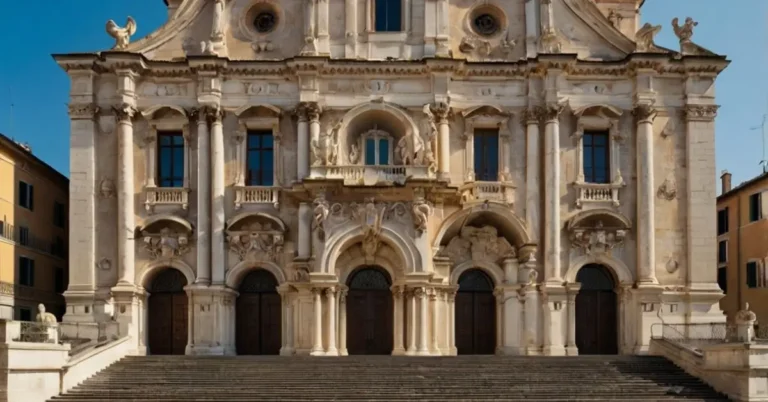The Chiesa San Luigi dei Francesi, or the Church of St. Louis of the French, stands as a testament to the grandeur of Baroque architecture and the rich cultural heritage of France in Rome. Located near Piazza Navona, this church not only serves as a place of worship but also as a repository of artistic masterpieces and historical significance. In this article, we delve into the architectural materials that constitute this magnificent structure, offering insights into its construction, design, and the artistic treasures it houses.
Architectural Materials of Chiesa San Luigi dei Francesi
Façade Composition
The façade of the Chiesa San Luigi dei Francesi is a remarkable example of Baroque architecture, designed by Giacomo della Porta and completed by Domenico Fontana in 1589. Constructed primarily from travertine limestone, the façade features two storeys adorned with Doric pilasters and Ionic columns, creating a harmonious and imposing exterior. The central entrance is flanked by statues of Charlemagne and King St. Louis, crafted by Pierre de l’Estache, which add to the façade’s grandeur.
Interior Materials and Design
Upon entering the church, visitors are greeted by an interior that exemplifies the opulence of Baroque design. The use of marble is prevalent throughout, with columns and altars crafted from various types, including red and green marble, which were sourced from different regions. These materials not only enhance the aesthetic appeal but also reflect the wealth and artistic patronage of the time.
Restoration and Preservation Efforts
Over the centuries, the Chiesa San Luigi dei Francesi has undergone several restoration projects to preserve its architectural integrity. In 2010, a significant restoration of the façade was completed, addressing issues such as pollution damage and structural wear. These efforts ensure that the church remains a lasting symbol of Baroque architecture and French heritage in Rome.
Artistic Masterpieces Within the Church
Caravaggio’s Paintings
One of the most renowned features of the Chiesa San Luigi dei Francesi is the Contarelli Chapel, which houses three masterpieces by the Baroque painter Caravaggio. These paintings—The Calling of St. Matthew, The Inspiration of Saint Matthew, and The Martyrdom of Saint Matthew—are celebrated for their dramatic use of light and shadow, bringing biblical scenes to life with intense realism.
Other Notable Artworks
In addition to Caravaggio’s works, the church contains other significant artworks, including frescoes by Domenichino depicting the Histories of Saint Cecilia. These pieces contribute to the church’s reputation as a center of artistic excellence and a must-visit destination for art enthusiasts.
Comparative Analysis of Architectural Materials
| Feature | Chiesa San Luigi dei Francesi | Other Baroque Churches in Rome |
|---|---|---|
| Primary Material | Travertine Limestone | Travertine, Marble |
| Column Styles | Doric, Ionic | Composite, Corinthian |
| Façade Sculptures | Charlemagne, King St. Louis | Various Saints and Popes |
| Interior Decoration | Marble Altars, Paintings | Marble, Frescoes, Stuccoes |
| Restoration History | Recent (2010) | Varied |
Conclusion
The Chiesa San Luigi dei Francesi stands as a monumental example of Baroque architecture, where the choice of materials plays a crucial role in its aesthetic and structural integrity. From the travertine façade to the marble interiors, each material was selected to reflect the grandeur and artistic aspirations of the era. The church not only serves as a place of worship but also as a repository of artistic masterpieces, making it a significant landmark in Rome’s rich cultural tapestry.
FAQ’s
- What materials were used in the construction of Chiesa San Luigi dei Francesi?
- The church primarily utilizes travertine limestone for the façade and various marbles for the interior columns and altars.
- Who were the architects behind the church’s design?
- The church was designed by Giacomo della Porta, with Domenico Fontana overseeing its completion.
- What are the notable artworks housed within the church?
- The church is renowned for Caravaggio’s paintings in the Contarelli Chapel and frescoes by Domenichino in the Polet Chapel.
- Has the church undergone any restoration efforts?
- Yes, significant restoration work was completed in 2010 to preserve the façade and address structural concerns.
- Is the church open to the public?
- Yes, the Chiesa San Luigi dei Francesi is open to visitors and is a popular destination for both religious and cultural tourism.
- Where is the church located in Rome?
- The church is situated near Piazza Navona, in the Sant’Eustachio district of Rome.

